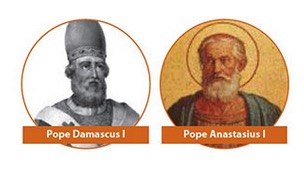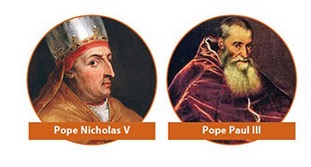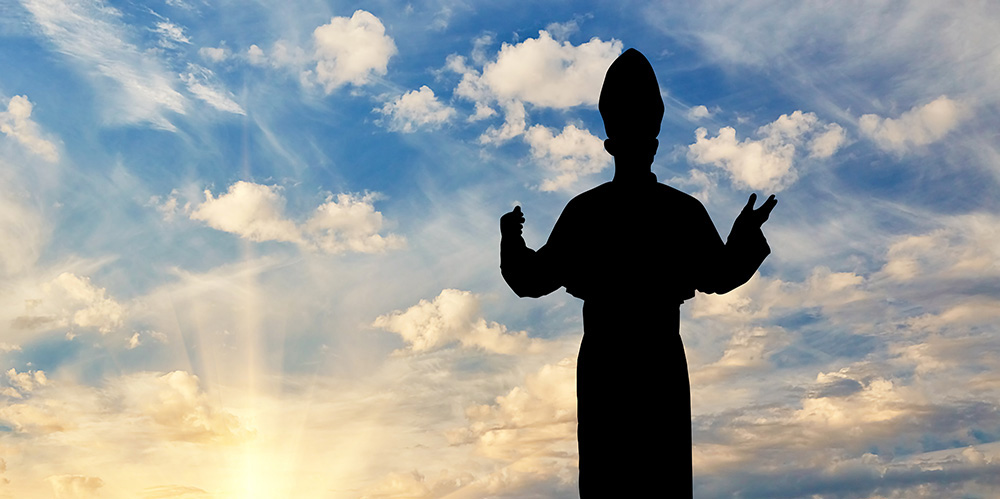Everyone has heard of the big-name popes.
There’s Gregory I the Great (r. 590-604), the first to call himself “servant of the servants of God.” There was the influential canon lawyer Innocent III (1198-1216), the warrior Julius II (1503-1513), and several popes named Pius, including Popes Pius VI (1775-1799) and VII (1800-1823), both of whom were taken prisoner by the French in the late 18th and early 19th centuries, respectively. More recently, we have the architect of the Second Vatican Council, John XXIII (1958-1963), and then the beloved John Paul II (1978-2005), maybe the next “Great” pope. But of the more than 260 men who succeeded Peter, there are many overlooked popes. While they weren’t all worthy of entry into a hall of fame, there were many who helped save the Church and change the papacy — and are worth meeting.
Consolidating Papal Power
For nearly three centuries, Christianity was an illegal religion in the Roman Empire, so the bishop of Rome could extend his authority beyond his city only rarely. During the fourth century, Roman emperors tolerated and then favored Christianity before finally making it the one, only and official religion of the empire. As a result, the bishop of Rome could now exercise his unique stature as Peter’s successor and extend his influence throughout the known world of Europe and the Mediterranean coast.
Pope Damasus I (366-384) built on what could be considered moments of papal authority in the Church’s early years. He inherited some examples of Roman bishops intervening in situations such as legal disputes, questions of leadership or Church doctrine and rules.
We might even say that he was one of the first “popes” in the sense that he consolidated and centralized papal authority as he acted above and beyond all the other bishops who, until that time, were referred to as papas (Greek for father), too.
Damasus said his decision was the ultimate one in disputed questions and cases, making himself the final court of appeals and asserting he could reverse a decision made by archbishops against bishops under them. He set himself up as arbiter when local or regional councils decided on a doctrinal statement or disciplinary action, claiming that no lower decision was final until he said so. Perhaps Damasus’ most influential decision was to commission Jerome, his secretary, to translate the Bible into Latin. This translation, which came to be called the Vulgate, was the authoritative biblical text for Christianity for centuries, and Jerome is honored as a Doctor of the Church.
A Papal Son
We are sure of at least three papal fathers and sons, but there was only one pair where the son directly followed his father. We should note that this happened at a time when the Church was trying to make clerical celibacy the norm, but priests with sons was not unusual and clearly didn’t stand between a man and the papacy at that time.
Anastasius I (399-401) was succeeded by his son Innocent I (401-417). Pope Innocent declared that nothing done by priests and bishops anywhere, no matter how far from Rome, could be considered to be settled until Rome’s bishop gave his approval or rejection. Once the bishop of Rome, acting with his authority as Peter’s successor, made that approval or switch, there was no higher authority to turn to. He also believed that the way liturgies were celebrated in Rome should be the norm for every other Christian site. As Innocent said, all streams flowed from Rome.
A Good Avignon Pope
From 1309 until 1377, the papacy moved to southern France, to a lovely region called Provence and a city that popes built into a lavish second-city Rome named Avignon. While there were good reasons for the papacy to leave Rome temporarily, the papal Curia became entrenched in what was deemed a nicer location and gained a fairly justified reputation for greed. The Italian humanist Petrarch (1304-1374) visited Avignon and declared it the Babylon of the West, which is why people call this period the Babylonian captivity of the papacy.
Recent scholarship reveals that while these decades were not the highest moments of Church history, the Avignon papacy was far from a rogues’ gallery. One pope stands out. Benedict XII (1335-1342) had a reputation as a strong investigator of heresy. Born Jacques Fournier, he was a spiritual man and a scholar: a member of the ascetic Cistercian order with a theology doctorate from the University of Paris, the most prestigious school of theology in the Church at the time. He was especially concerned with improving the quality of Church leaders: we find no evidence of nepotism in his record, and he instituted more rigorous examination of candidates for high offices.
Pope Benedict fought absenteeism by sending home any priest or bishop in Avignon whose primary job was being a pastor somewhere else. At the same time, it seems he gave up the idea of returning to Rome: he built a huge fortresslike palace, transferred the papal archives to Avignon and reserved for himself many appointments, which had previously been left on the local level, to prevent corruption.
The Humanist Pope
Nicholas V (1447-1455) reigned when the papacy was trying hard to regain its footing after the setbacks of the Avignon papacy and the Great Western Schism. Originally Tommaso Parentucelli, as a young man, he was right in the middle of the Renaissance flowering of art, architecture and literature in the key city of Florence, Italy.
Pope Nicholas did much to restore not only the papacy but Rome as its vibrant heart. He made 1450 a jubilee year, which rejuvenated the city’s economy. Led by Nicholas’ example, Roman families were generous patrons to painters, sculptors, architects, engineers, tapestry designers, weavers and metalsmiths. Nicholas was also interested in the written word and essentially established the Vatican Library.
Pope Nicholas collected Greek and Latin manuscripts, often directing that other documents in different languages be rendered into Latin for the archives. He used money gained during the jubilee year to send agents throughout Europe and the Mediterranean to find, buy or copy manuscripts.
Even the very word Vatican that we use as shorthand for what the pope and Roman Curia are doing gained new meaning because of Pope Nicholas. The papal home and headquarters had for over a millennium been in and around the Lateran basilica and palace, which the Roman emperor Constantine donated in the early fourth century. Nicholas moved the papal offices to the Vatican hill in Rome, in part because of its historic connection with Peter, the site of whose death and burial had been marked there for centuries.
Not only did he relocate the papal bureaucracy there, but, as part of his program to recover papal prestige and burnish its reputation, he made the decision to build a new St. Peter’s Basilica, which eventually became the structure standing there now.
The Unlikely Reformer
One would think that a 25-year-old cardinal who received the honor of a red hat because his sister was a papal mistress would be the last person leading efforts to reform the Church, but that’s just what happened with Pope Paul III (1534-1549). Born Alessandro Farnese to a powerful family, he lived the typical, if distressing, life of some Renaissance cardinals. Not long after being elected pope, he named two of his teenaged grandsons cardinals and gave other offices to his family members.
But while at the same time guilty of nepotism, something changed in the man. His mind turned toward reform in the years just after Martin Luther posted his 95 Theses in 1517. As pope, he appointed reform-minded cardinals to the Curia and brought churchmen from outside Roman circles to prepare a report on what was wrong in the Church, knowing that a perspective from afar was needed to break up the entrenched in-house mentality of protecting the home office.
Although Pope Paul III could not move against the papal bureaucracy as quickly or completely as he would have liked, he still set into motion the reform mindset that would result with the Council of Trent, which first met during his papacy in 1545. He also looked forward to the future of Catholicism even as those around him counseled retrenchment against Protestantism.
Pope Paul encouraged innovative religious orders, such as the Ursulines (founded in 1535 by St. Angela Merici), with their ministry to poor girls, and the Jesuits (approved by Pope Paul in 1540), deeply involved in evangelization, missions, education and the Catholic Reformation.
Resurrecting Peter
Pope Sixtus V (1585-1590) was another builder pope who responded to the Protestant rejection of the papacy by resurrecting the importance of Peter and his successors as vicars of Christ. Born Felici Peretti, he continued building the new St. Peter’s Basilica, and it was during his pontificate, in fact, that the dome of the basilica was finally completed. He likewise reorganized the Curia into fifteen permanent congregations headed by cardinals, a system that is still in existence. He also tied the current Church in with its historic past in Rome by celebrating Lenten liturgies in the city’s oldest churches, where they had first been observed. As one of his preachers said, “O blessed are we, we who behold today living and breathing that ancient form of the Church.”
In a real sense, it is Sixtus V’s city that pilgrims continue to visit — the city of Peter and his successors.
Christopher M. Bellitto is associate professor of history at Kean University in Union, N.J. He is the author of “Church History 101: A Concise Overview” (Liguori Publications, 2008) and “101 Questions and Answers on Popes and the Papacy” (Paulist Press, 2008).

